| Columns Retired Columns & Blogs |
Linn Klimax Kontrol preamplifier & Klimax Twin power amplifier Measurements
Sidebar 3: Measurements
Looking first at the drop-dead gorgeous Klimax Kontrol preamplifier, its maximum voltage gains with the volume control set to "100" were 10.26dB (unbalanced input to unbalanced output) and 16.2dB (balanced I/O). The volume control operated in accurate 0.5dB steps, with the displayed volume number calibrated in dB. The 0.5dB steps are indicated with a period after the number, the unbalanced unity-gain position (if it existed) falling between "90" and "89." The preamp preserved absolute polarity through both its unbalanced and balanced inputs (the latter are wired with pin 2 hot), and the input impedance at 1kHz measured 10.3k ohms unbalanced and 7.8k ohms balanced.
The unbalanced output impedance was 299 ohms across the audioband, this doubling from the balanced XLRs. The unbalanced frequency response is shown in fig.1. The ultrasonic -3dB point lay at 160kHz; the balanced response was identical. The response did not change with the volume-control setting, other than the superb channel balance degrading by 0.2dB at the top of the range. Channel separation was superb, any crosstalk being buried beneath the noise floor. The signal/noise ratio with the inputs shorted and the volume control at "100" was good, at 74.6dB (wideband, unweighted), this improving to 87.5dB when the measurement bandwidth was restricted to the audioband. The A-weighted figure was 91.1dB. (All figures referenced to 1V output.)
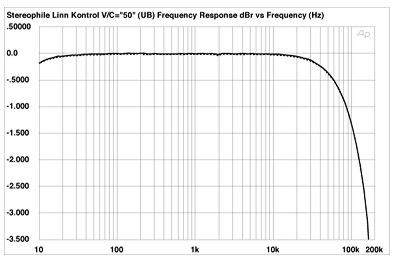
Fig.1 Linn Klimax Kontrol, unbalanced frequency response at 1V into 100k ohms with volume control at "50" (0.5dB/vertical div., right channel dashed).
The Kontrol could deliver more than enough output to drive any partnering amplifier into clipping. Fig.2 shows how the percentage of THD plus noise present in the preamp's unbalanced output varies with output voltage. Just over 6V RMS is available into 100k ohms at the nominal 1% THD clipping point, this dropping slightly into 10k ohms. Even into a punishing 1k ohm load, 4.75V are available, this equivalent to an input voltage of 2V. As anticipated, the balanced output could swing twice as many volts into the same impedances (not shown).
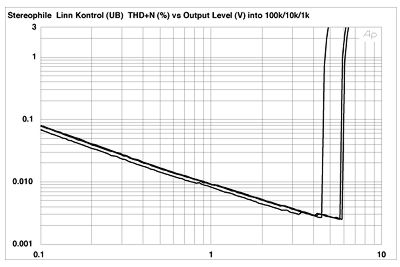
Fig.2 Linn Klimax Kontrol, unbalanced distortion (%) vs 1kHz output voltage into (from bottom to top): 100k ohms, 10k ohms, 1k ohms.
The measured THD+noise percentage was below 0.01% over most of the audioband from both sets of outputs. Fig.3 shows the behavior from the balanced XLRs, at 1V RMS into 100k and 600 ohms. The lower pair of traces is into the low impedance. This appears lower than into 100k because I had to raise the input voltage to keep the output at 1V. As the measured THD+N percentage at this level is dominated by noise (see fig.2), the increase in input lowers the measured figure.
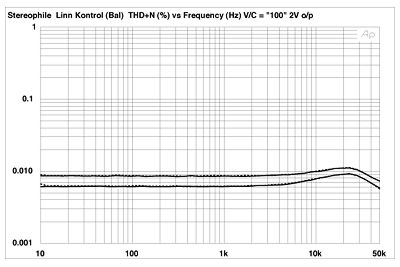
Fig.3 Linn Klimax Kontrol, balanced THD+N (%) vs frequency (from bottom to top at 4kHz): 1V into 600 ohms and 100k ohms (right channel dashed).
The harmonic content of the distortion showed some changes with output level. Fig.4, taken at 300mV from the unbalanced output into 8k ohms, reveals the distortion to consist of the second harmonic at -89dB, the third at -98dB, and the fourth at -105dB. Increasing the output voltage to 1V (fig.5) changes the pattern, with now the third harmonic the highest at -90dB, and the fifth, sixth, and seventh harmonics now making appearances. Given how low in level these harmonics are, this behavior is probably of only academic interest, but I felt it worth noting. Intermodulation distortion was also extraordinarily low, with the spuriae in fig.6 of the order of those in the D/A converter I used as a source.
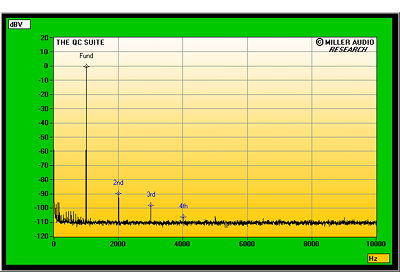
Fig.4 Linn Klimax Kontrol, unbalanced spectrum of 1kHz sinewave, DC-10kHz, at 300mV into 8k ohms (linear frequency scale).
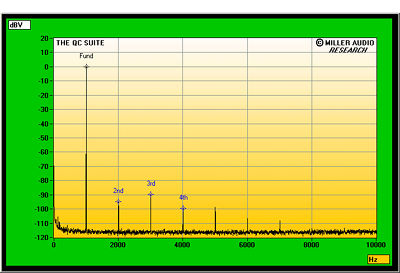
Fig.5 Linn Klimax Kontrol, unbalanced spectrum of 1kHz sinewave, DC-10kHz, at 1V into 8k ohms (linear frequency scale).
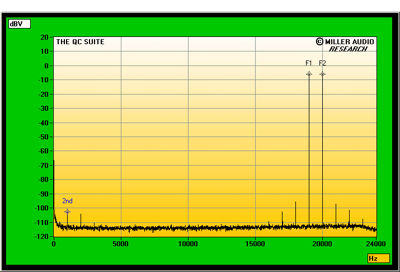
Fig.6 Linn Klimax Kontrol, unbalanced HF intermodulation spectrum, DC-24kHz, 19+20kHz at 1V into 8k ohms (linear frequency scale).
Before I performed any measurements on the Klimax Twin, I preconditioned the amplifier by running it with both channels driven at one-third power into 8 ohms for an hour. The top panel reached around 55 degrees C at the end of this period, but the tunnel-mounted fan didn't come on, showing that the aluminum casework is an effective heatsink.
The Linn didn't invert absolute polarity through either input—again, pin 2 of the balanced XLR is wired as hot—and the input impedance was to specification at 7.8k ohms, balanced and unbalanced. Those wanting to mix'n'match should note that this is on the low side for some tube preamplifiers—the BATs and CATs, for examples, which will sound lean as a result. The maximum unbalanced voltage gain (into 8 ohms) measured 28.6dB, this decreasing by 6dB via the balanced input, as specified.
The output impedance was a lowish 0.14 ohm across the audioband, meaning that there will be little modification of the amplifier's response by the voltage-divider action of its impedance and that of the partnering loudspeaker. (See Tom Norton's 1994 article on the subject. This can be seen in fig.7, where the top dotted trace shows the Klimax Twin's response into our simulated loudspeaker. Into a pure resistive load, the Linn amplifier's response is 3dB down at 58kHz, a little higher than the specified 35kHz, which results in an output down by 0.5dB at 20kHz. This curtailed ultrasonic response also rounds off the leading edges of a 10kHz squarewave (fig.8), but the waveform is refreshingly free from overshoot or ringing.
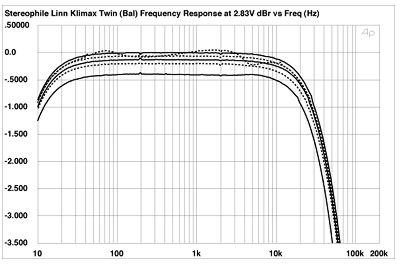
Fig.7 Linn Klimax Twin, balanced frequency response at (from top to bottom at 2kHz): 2.83V into dummy loudspeaker load, 1W into 8 ohms, 2W into 4 ohms, 4W into 2 ohms (0.5dB/vertical div., right channel dashed).
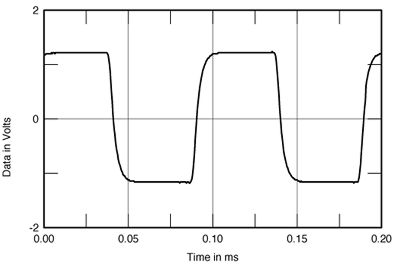
Fig.8 Linn Klimax Twin, small-signal 10kHz squarewave into 8 ohms.
Note that there is a very slight hint of a peak around 6kHz in the 2-ohm trace in fig.7. This response was taken via the Twin's balanced input; via the unbalanced input (not shown), this peak reached +0.2dB referenced to the level at 1kHz. I have no idea what this behavior was due to. It does coincide with one of the impedance minima of the simulated speaker load, which was being driven by the other channel when I performed this test. But perhaps this is a coincidence—when I drove resistive loads with the Klimax Twin, I could hear some acoustic output coming from the amplifier chassis at this same frequency, even at low power levels. Peculiar.
I assess channel separation by shorting one channel and looking at its output while I sweep a high-level tone in the other channel. When I examined the Klimax Twin's behavior, I got such anomalous results that I thought I must have miswired the test setup. But after checking what I had done I repeated the measurement and got the same results (fig.9). The balanced input (bottom pair of traces below 7kHz) gives somewhat greater channel separation, but neither pair of inputs is outstanding in this respect. And note the distinct shape of the crosstalk traces in the region where I noted the anomaly in the low-impedance response trace (fig.7).
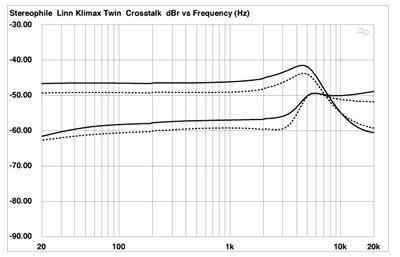
Fig.9 Linn Klimax Twin, channel separation, unbalanced drive (top) and balanced drive (bottom). (10dB/vertical div., R-L dashed.)
- Log in or register to post comments




































